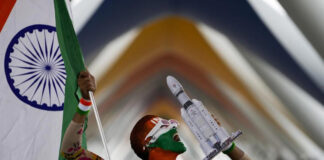JULY 28, 2019
Did you know that 12 people have visited the moon?
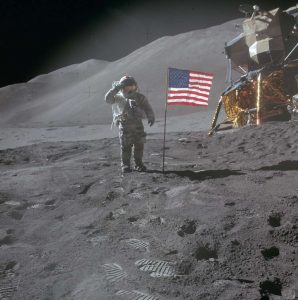 Astronaut Dave Scott salutes the U.S. flag on the moon. Flags are some of the “gifts” left on the lunar surface. – NASA/NASA
Astronaut Dave Scott salutes the U.S. flag on the moon. Flags are some of the “gifts” left on the lunar surface. – NASA/NASA
It’s been 50 years since the moon’s first visitors arrived July 20, 1969. When Neil Armstrong took humans’ first step on the lunar surface, 600 million people crowded around televisions to watch.
The world couldn’t wait to see what the astronauts brought home — mysterious moondust and ancient rocks. But the astronauts didn’t just take things from the moon. They left things behind, including science experiments, tools, backpacks, boots and food pouches. The astronauts also gave the moon a few special gifts.
The Apollo 11 crew, the first moon walkers, brought a silicon disc the size of a 50-cent piece to leave on the moon. It contained “goodwill messages” from leaders of 73 countries written in tiny letters etched on the disc. Each message promoted friendship. One from Pierre Trudeau, Canada’s prime minister at the time, read: “Man has reached out and touched the tranquil moon. May that high accomplishment allow man to rediscover the Earth and find peace there.”
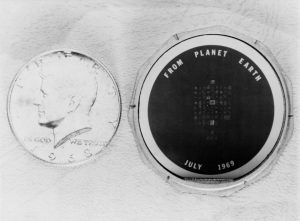 A close-up view of the silicon disc, right, that would be left on the moon by Apollo 11 astronauts. The disc has messages of goodwill from world leaders. It is slightly larger than a half-dollar coin, left. – NASA/NASA
A close-up view of the silicon disc, right, that would be left on the moon by Apollo 11 astronauts. The disc has messages of goodwill from world leaders. It is slightly larger than a half-dollar coin, left. – NASA/NASA
The disc was placed inside an aluminum capsule to protect it from harsh temperatures on the moon. The astronauts left the capsule in the Sea of Tranquility, the area where they landed and explored.
In February 1971, Alan Shepard (Apollo 14) surprised the world when he bounced across the moon carrying a golf club and two golf balls he had smuggled onboard. With a TV camera rolling, Shepard attempted several one-handed swings before finally sending a ball soaring about 200 yards through space. Those two balls became unique gifts to the moon. (They’re buried beneath the moondust.)
When Charles Duke arrived on Apollo 16 in 1972, he brought a personal gift. On his last day, he placed a photo of his family — Duke, his wife and their two young sons — on the gray, dusty surface. But after all these years, the picture has probably faded to white, according to Dave Williams from NASA’s Goddard Space Flight Center in Greenbelt, Maryland.
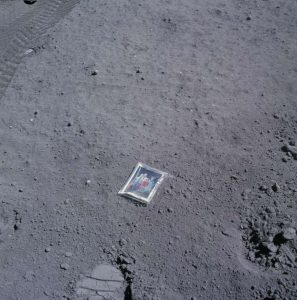 Charlie Duke put a photo of his family — including wife Dotty and sons Charles and Tom — on the lunar surface and took several photos of it. He left the photo there. – NASA/NASA
Charlie Duke put a photo of his family — including wife Dotty and sons Charles and Tom — on the lunar surface and took several photos of it. He left the photo there. – NASA/NASA
“The moon has no atmosphere, it has no protection from [ultraviolet] radiation, and so the sunlight is particularly intense,” Williams explained.
All six moon missions each left behind a U.S. flag planted in the rocky soil. But Williams says they’ve probably vanished by now.
“The flags were made of nylon,” he said, “so it’s likely that the intense UV radiation, combined with the temperature extremes, may have caused them all to disintegrate over the past almost 50 years.”
The last three missions — Apollo 15, 16 and 17 — each brought a lunar rover. Could future explorers take them out for a spin? Not so, Williams says.
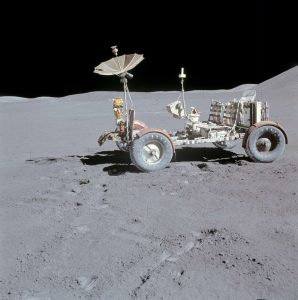 A battery-powered lunar rover from the Apollo 15 mission. It wouldn’t be usable for a future mission. – NASA/NASA
A battery-powered lunar rover from the Apollo 15 mission. It wouldn’t be usable for a future mission. – NASA/NASA
“They were battery-powered. On the moon, temperatures range from almost 250 degrees during the day to below minus-250 at night. This would destroy a battery.”
Although most items on the moon have been damaged by severe temperatures and harsh sunlight, Williams says, one kind of memento from the moon landings remains.
“We can see the tracks the astronauts left behind in pictures taken today by the Lunar Reconnaissance Orbiter. Since there is no air or water on the moon, there is almost nothing to wipe away the tracks, so some of them may last for millions of years.”
Those footprints are a permanent reminder of 12 brave visitors.
Courtesy/Source: Washington Post





































































































